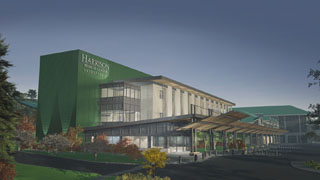|
Subscribe / Renew |
|
|
Contact Us |
|
| ► Subscribe to our Free Weekly Newsletter | |
| home | Welcome, sign in or click here to subscribe. | login |
Architecture & Engineering
| |
 |
July 26, 2012
Silverdale hospital sets ambitious budget for new wing
Andersen Construction and Rice Fergus Miller

Olson
|

Miller
|
The need for more and better health care facilities comes at a time when the health care industry is tightening budgets due to a variety of constraints. This isn’t a roadblock to building new hospitals, but it does mean the design and construction industry needs to alter its approach to the way hospitals are built.
Currently, more than 2,000 orthopedic surgeries take place at Harrison Medical Center’s two locations in Silverdale and Bremerton. The number of people requiring orthopedic care in Kitsap County is projected to grow by 20 percent in the next five years.
To meet this need, Harrison Medical Center recently broke ground on its new orthopedic hospital on the Silverdale campus, which will be dedicated to inpatient orthopedic and joint replacement surgery. Slated for completion in the summer of 2013, this three-story, 54,000-square-foot expansion will feature four large operating rooms, 16 pre- and post-surgical recovery bays, 50 private patient rooms and a rehabilitation gym, in addition to other support areas.
Harrison Medical Center set an aggressive goal to design and build this new facility on a tight schedule and for less than $315 per square foot, including site development costs. This is a budget goal that is significantly below what is currently being seen in the Puget Sound region for an inpatient facility of this type.
Based on previous experience with Harrison and other regional health care facilities, Bremerton design firm Rice Fergus Miller accepted this challenge. Together with Seattle-based Andersen Construction, they developed a modified integrated project delivery (MIPD) approach to the project, working closely with Harrison facility staff and the Orthopaedic Alliance on the Peninsula.
The overall design and construction schedule is 18 months, from start of design to owner occupancy. The final cost works out to be approximately $314 per square foot, including the buildout of the currently shelled third floor patient rooms and renovations within the existing hospital facilities on site.
A new hospital wing for less than $315 per square foot? Yes, it can be done.
Detailed mock-ups
To expedite the design process and obtain real-time user and administration feedback, Rice Fergus Miller and Andersen Construction designed and constructed full-scale mock-ups of a patient room, surgery suite and preoperative suite. The mock-ups were built in space set aside specifically for this purpose in Rice Fergus Miller’s office and studio.
The mock-ups were furnished and equipped with medical equipment from Harrison Medical Center or provided by potential vendors. Casework for the spaces was built from foam core to the proposed dimensions. All data, power and medical gas outlets were located in the mock-ups, including those that would be in the ceilings, ceiling columns and in-floor pedestals.
These detailed mock-ups were critical to the decision-making process. Clinicians and stakeholders were invited to take tours and provide feedback on everything from overall space functionality to where to put the hamper to maximize infection control, resulting in a comprehensive examination of the ideal patient care environment.
The mock-ups translate to cost savings for several reasons. The design and construction team was able to guarantee that the “built” condition of the patient care spaces is accurate and accepted by the users, eliminating costly (in terms of both time and money) changes in the field. Also, the mock-ups helped build trust with the end users by showing that the design team understands what’s important to them and has their best interests in mind.
Simplified design
One of the mottoes for the project was, “Don’t draw it until we know we can afford to build it.”
This approach saved the design team from spending time on options that wouldn’t work within the budget. Every major design decision was discussed by the team, vetted by the hospital and priced before moving forward.
For example, the decision was made to use a concrete masonry unit (CMU) and steel-frame structural system. The CMU provides a cost-effective exterior wall system that is architecturally pleasing, efficient to build and complementary to the existing architecture of the hospital building to the south.
The use of CMU has many advantages. It represents value in that the structural skin of the building is also the exterior finish, which eliminates the need for two systems to support and finish the facade.
Mechanical and electrical systems were likewise scrutinized for performance, maintenance, life-cycle cost and first cost in order to achieve a balance of energy efficiency, ease of maintenance, and patient and staff comfort.
The design concept for the project responded with a simplified building design: a rectangular shape, simple structural grid, and uniformity and repetition of major elements.
The patient rooms are designed to enhance safety and comfort, incorporating alcoves for family and staff areas without adding space to the floor plan. At one moment during the mock-up tours, a surgeon pulled out a tape measure to measure the width and depth of the room. He commented that the dimensions of the rooms are not much different from others at Harrison Medical Center, but they feel much larger.
Off-site construction
The success of the MIPD process is only as good as the trust and collaboration between owner, architect and contractor.
Andersen Construction was able to co-locate to Rice Fergus Miller’s office for a few days each week during design and preconstruction. This allowed the design team to make informed decisions and respond to design, cost and detailing input immediately.
Input from subcontractors was sought early on in the process and these ideas were incorporated into the design where appropriate. Steel connection details, CMU coursing and expansion joint layout, window waterproofing systems and metal panel design were all done with the help of subcontractors.
Andersen Construction drove a prefabrication effort that involves off-site construction of headwall systems, bathroom pods, window systems and casework. This effort alone shaves one month off the construction schedule and saves significant cost on the mechanical, electrical and plumbing subcontracts.
Prefabrication, much like an assembly line, streamlines the construction process and standardizes it to a point where the durations of each task become dramatically faster. It also decreases the workforce required during construction, making the management of people on site more efficient.
Harrison Medical Center’s intent was to design and build a state-of-the-art orthopedics hospital to enhance their standing in the marketplace. They challenged their design and construction team to create a project that met their clinical and financial needs. By all accounts, the team has succeeded.
Eric Olson, a senior project manager with Andersen Construction, has spent the majority of his career building health care projects in the Seattle area. Mike Miller, senior principal of Rice Fergus Miller, has over 29 years of experience in design for the health care industry.
Other Stories:
- Lean design is different for every health care project
- Simulations playing wider role in nursing education
- Former TV studio remodeled into dialysis clinic
- Virtual tools put Everett tower on the fast track
- Clinic designs evolving to meet growing list of needs
- Hospital’s mechanical design process a complex dance
- When hospitals expand, traffic concerns follow
- Tight UW site left nowhere to go but up
- Builder’s challenge: Keep UW hospital running smoothly



